Initially posted: 15 Dec 16
Updated: 22 Mar 17
Abstract
The goal of this study was to explore the impact of the OCD distribution device on espresso as measured through total dissolved solids (TDS) extraction with a coffee-correlated refractometer (VST LAB III) and shot time. The dependent variables collected were shot time, beverage mass, and TDS. Independent variables included: 1) use of the OCD/no OCD and 2) grinder. Results showed a significant reduction in TDS/extraction yield using the OCD (p < 0.01), a significant difference in TDS depending on grinder used (p < 0.01), and a significant interaction of OCD x grinder (p < 0.01), as well as a significant effect of grinder on shot time (p < 0.01) and a significant interaction between grinder and OCD (p = 0.03). An additional test, following similar procedures as those outlined here, was performed comparing the OCD 2, another distributor tool (shown here, referred to as “BT” distributor), and no distributor. Results showed a significant reduction in TDS/extraction yield only with the OCD 2 compared to the control condition (p < 0.01) and compared to the BT distributor (p < 0.01). No statistically significant difference was seen between the BT distributor and control condition. Results shown here.
Bottom line
Based on our data, use of the OCD and OCD 2 consistently led to lower TDS in espresso shots (and corresponding extraction yield, given all conditions had equivalent final beverage mass). We also observed different grinders led to significantly different extraction levels, with the Mythos One having consistently less variability compared to the K30 and Anfim. Lastly, the interaction effect suggests the impact of the OCD on TDS varied based on the grinder used, but this is most likely due to the overall reduced variability seen with the Mythos One grinder relative to the other grinders.
Disclosures
We have no vested interest in any of the products being used for this experiment. All products used in this experiment were purchased by Socratic Coffee team members.
Authors
Jeremy and Joe
Introduction
After dosing ground coffee into a portafilter basket, very often the coffee is unevenly distributed. To more evenly disperse coffee throughout the basket, baristas have adopted a variety of different techniques. In the past few years, a surge of tools to help with this process have emerged. The mechanisms of action between these various tools may vary to some degree, but the end goal is the same: more evenly distributed coffee grounds in the portafilter basket, potentially creating more uniform density throughout the puck before it is tamped.
The three main hypotheses for this experiment were 1) use of the OCD would lead to significantly higher TDS/extraction yield, 2) the grinder being used would have a significant effect on TDS, and, 3) no significant interaction would be seen between use of the OCD and grinder.
Methods
The coffee used for the experiment was a blend of Ethiopian Sidamo Guji and Brazil Mogiana. Coffee was rested for 7 days before use. The same batch of roasted coffee was used for the entire experiment. Room temperature was between 19°C-24°C and humidity 65%.
Equipment used:
- La Marzocco (LM) Linea ABR, two group fitted with 0.6 mm restrictor and standard double portafilter with the 20g VST basket filter, set at 9 bar water pressure (verified with a Scace II); brewing temperature 94°C regulated with a PID on board, built-in scales were calibrated prior to the experiment
- Water filter used for the experiment was Brita Purity C150 Quell ST
- Anfim SPII Special Performance / Mythos One / Mahlkonig K30 coffee grinders (once dialed in using the OCD for each grinder, the grind setting was maintained for all conditions–beverage mass goal of 40g in 30 s)
- Two scales (Ohaus Navigator XL calibrated prior to the experiment to measure the dry coffee dose)
- Pen and paper to record values
- 50+ empty ramequin bowls for measuring the mass of the shot
- 50+ empty small ramequin bowls for TDS measurement
- Pullman TampSure ensuring same depth tamping no matter how much pressure is applied (depth exceeded that of the maximum point of the OCD by more than 2 mm)
- Portafilter stand
- OCD Distributor
- Brush to wipe off coffee of OCD
- VST LAB III 4th Generation refractometer, zeroed according to manufacturer guidelines
- Distilled water
- Alcohol pads
- Infra-red gun to measure the solution prior to refractometer measurement (under 30°C degrees, average 27.5°C)
- Pipette/Serviettes
- Microfiber towels
The conditions with the grinder and espresso machine were constant for all conditions. The room temperature was controlled with air conditioning at approximately 24 °C for the duration of the experiment.
Within a specific grinder, the condition order (OCD/no OCD) was randomized. Further, three experimenters were used. One experimenter dosed and distributed coffee in the basket (using the OCD or gentle tapping).
- OCD Dosing: The dosing of the OCD was carried out consistently all across coffee grinders. Each shot of coffee was ground and carefully dispensed in the middle of the portafilter. Weighing the amount of coffee in the portafilter on the scales, some of the shots required adding/removing +/- 0.5-1g of coffee and this was done by using a small spoon. The portafilter was placed on a stand and each shot was distributed with an OCD, occasionally using a small brush to remove ground coffee was stuck on the base of the OCD due to static. The portafilter was re-weighed to make sure the dry dose of coffee was 20g. The portafilter was then carried to another experimenter who tamped the coffee consistently using the TampSure and portafilter stand, as well as pulled the shot to the beverage mass goal, recording shot time. A final experimenter measured the shot TDS.
- NO OCD Dosing: The dosing of the No OCD was carried out consistently all across coffee grinders. Each shot of coffee was ground and carefully dispensed in the middle of the portafilter. The portafilter was gently tapped on the fork of the coffee grinder** and weighed on the scales by adding or removing any necessary coffee (+/- 0.5-1g of coffee). The portafilter was then carried to another experimenter who tamped the coffee consistently using the TampSure and portafilter stand, as well as pulled the shot to the beverage mass goal, recording shot time. A final experimenter measured the shot TDS.
**Because the incorporation of a “gentle tap” differed between OCD and No OCD conditions, we did a study specifically to assess any impact a gentle tap versus no tap may have. No significant difference was found between tap and no tap.
A brew ratio of 1g coffee to 2g brew weight was used (i.e., 20g dose for 40g final beverage mass). Because TDS is most strongly correlated with beverage mass, shots were all pulled to a consistent mass. Time to reach this weight was recorded. Shots were performed at 9 bar pressure
All TDS samples were performed following VST recommended guidelines.
Results
All analyses were performed using R 3.1.1 and Excel 2016. Data was first analyzed with de-identifying generic labels and matched via a key to the appropriate conditions after analysis was complete (i.e., data was analyzed in a blind manner). Data was first assessed to ensure it does not violate assumptions for multivariate analysis of variance (MANOVA) using Condition (OCD/No OCD) and Grinder (K30, Mythos, Anfim) as independent variables and Shot Time and TDS as dependent variables. Beverage mass values between conditions were compared via t-tests and revealed no significant difference. A MANOVA utilizing the Pillai test, showed a significant effect of Condition (F(1,54)=61.5, p<0.01), Grinder (F(2,54)=14.6, p<0.01), and Condition x Grinder (F(2,54)=3.5, p<0.01). More specific ANOVAs and contrasts were then utilized to better explore relationships in the data (outcomes shown in figure below).
For total dissolved solids:
**Update as of 07 Sep 20: Please note that all p<0.00 should read as p<0.01**
For total dissolved solids between the OCD 2 and BT distributors:
For shot time:
(Raw data can be downloaded in a tab delimited text file here--and OCD2/BT testing data here. As always, while we offer the data for your personal use, we kindly ask that you send a message to info@socraticcoffee.com before posting or presenting it in any public forum and attach appropriate acknowledgement.)
Conclusions
Because our dose and final beverage mass does not vary significantly between conditions, any differences observed in TDS can be extrapolated to differences in extraction yield (EY). Our last hypothesis, regarding the interaction between the independent variables, would suggest that an effect seen when using the OCD would be evident with all grinders. This could be related to consistency in the OCD’s effect. Our results may suggest variability inherent in the grinder itself with regard to TDS/EY can overcome any negative impact on extraction created by the OCD.
Did the OCD lead to more consistent extractions? Given our data, this does not appear to be true. Using our metrics (TDS and shot time), “more consistent” would imply “less variability within a condition”. The amount of variability did not vary between OCD and non-OCD conditions. The most consistent effect was a reduction of shot TDS when using the OCD. For shot time, in two of the three grinders used, there did appear to be a slight reduction in overall variability after use of the OCD (the significant interaction effect). However, this was not seen for all grinders and did not alter the overall extraction of dissolved solids.
Why the OCD consistently reduced extractions is not clear. Tamping provides a compression force to coffee particles in a puck. The OCD device may apply a significant amount of shear force. Why the OCD’s effect was so pronounced with all grinders only in TDS and not shot time is also not understood. Any negative impact the OCD may have on coffee particle arrangement, bed architecture, etc. that could potentially impact extraction would seemingly have a corresponding impact on shot time.
We intentionally did not collect or present any subjective data. We feel it is the role of the barista/café owner to determine the desired taste given his/her equipment, coffee, water, and preference. Our data is meant to compliment and better inform the coffee community so that they may arrive at their desired taste more efficiently, effectively, and consistently. It is possible the OCD shots of lower TDS/EY would be preferred by the barista/consumer. Further, while somewhat unlikely, it may be possible that the content of extracted solubles differed when using the OCD.
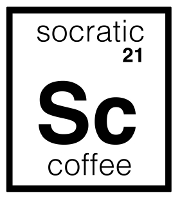
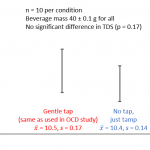
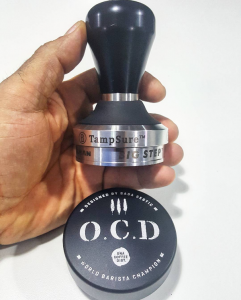
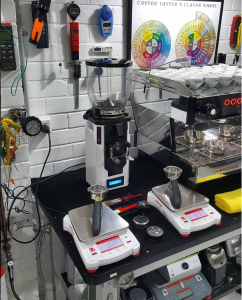
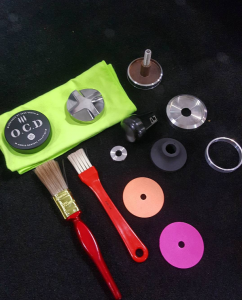
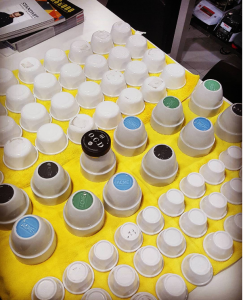
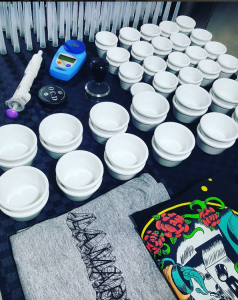
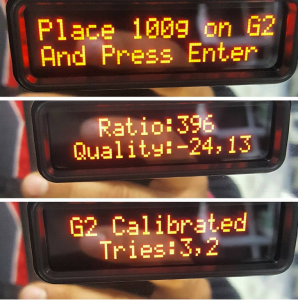

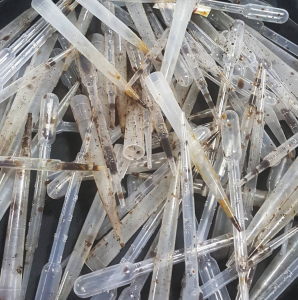
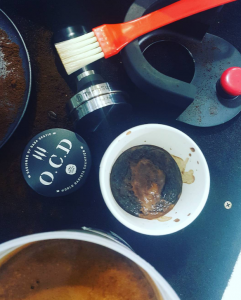
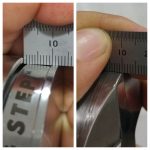
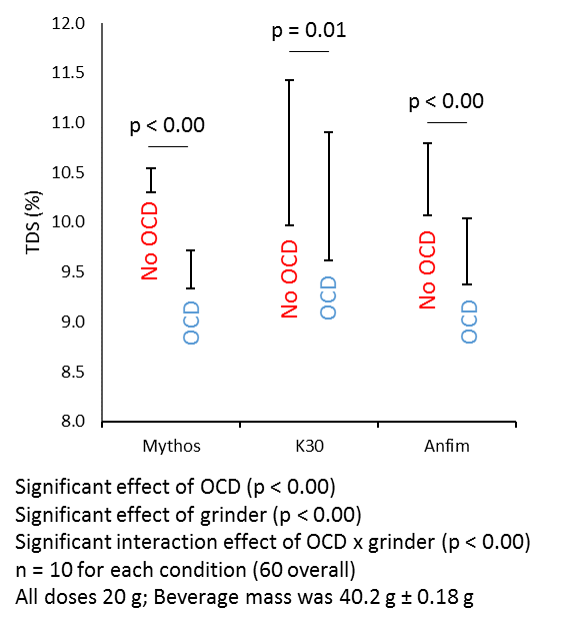
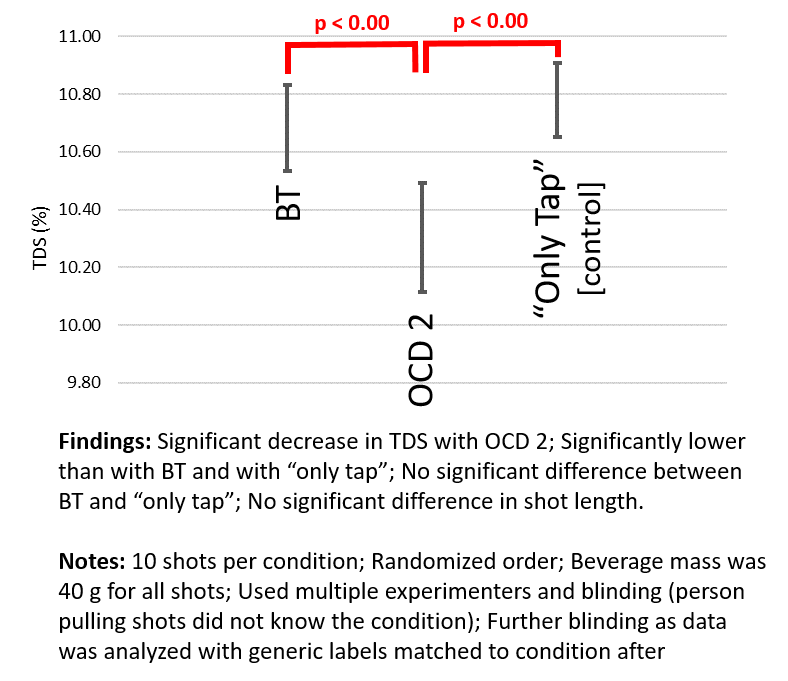
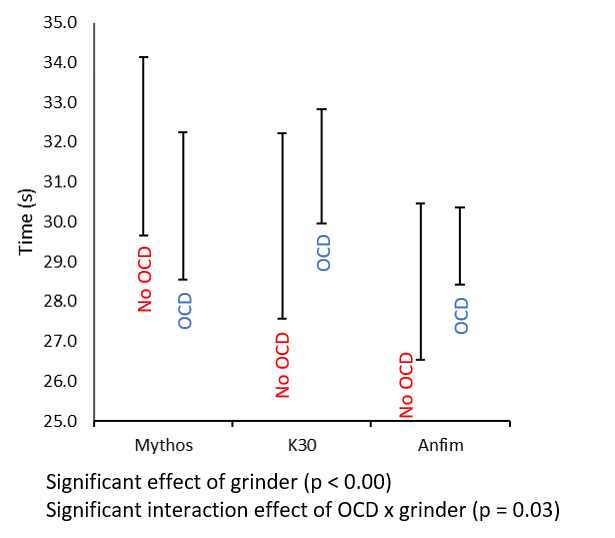
Philip J. Espresso
Would the use of the OCD merely act as a wave type initial tamp followed by a distribution of remaining loose material? Tamping after this would then compact further the initial wave tamp.
The result, I feel, would be a more uneven tamp with water being led more predominantly through the channels that did not receive the initial impact of the OCD being pressed into the coffee.
For this to be a useful tool, it may have to be able to rotate as it is being lowered into the basket and onto the coffee. This would encourage a more even distribution before tamping.
Radu
Look at the videos for the OCD. You rotate it to get even distribution.
Philip J. Espresso
Yes you rotate it after you put it on top of the coffee.
Chris A
I had a similar tool to the OCD which could work as per the OCD or be rotated as it descended and I found the latter approach led to less channelling and more consistent results so I’ve been hoping to see some experiments exploring that approach.
Tom
That was the question in my head. Might lead to albeit, slight channeling…?
Jeremy
It’s hard for us to quantify channeling (and not possible given the approach used in this study). The mechanism by which the OCD reduced extraction is not clear. Perhaps it was due to increased channeling, we just can’t say for certain. In conditions with no distribution and direct tamping (“tap and tamp” as well as “no tap, just tamp”), the OCD reduced TDS but did not cause a significant difference in shot time. So if channeling was an issue, it was not enough to alter overall shot time–so maybe some form of “micro-channeling”?
Blake
That`s brilliant!What a coincidence I was planing this experiment these days and already started ,of course not as this volume as you did (more than 60 is a loooot!).then I saw your work ,so much precise.
Thank you very much for sharing this .
And also ,can I translate your article into Chinese to share with Chinese baristas and coffee lovers?Of coures I will also post your original website at the same time .
Again thankyou very much for sharing ackonwlage.
Jeremy
Hi Blake,
Sure, with a link back to the original article and proper credit, translating it would be fine.
Thanks,
Jeremy
Matt
Awesome write up guys, thanks for this info.
Can you “unofficially” comment on taste preferences with and without the OCD you found through your experiments? As in, did you find the lower TDS shots had more even extraction and a better taste?
Keep up the good work! 🙂
Jeremy
Hi Matt,
Sorry, we don’t comment on taste… what does a “more even extraction and a better taste” mean? What does a more even extraction taste like? Does a better taste mean more sweetness or do you have a preference for higher acidity, greater body, etc.? After doing years of human performance research for a variety of applications, and judging for barista competitions, one thing that has become obvious to us are the challenges in subjective experience quantification (and qualification). The World Coffee Research’s Sensory Lexicon has attempted to bring some standardization to the subjective measurement and description of coffee’s sensory qualities by referencing sensory descriptions and strengths to non-coffee item standards. We think this is a great step in the right direction, but still far from allowing us to say anything like “this tasted more evenly extracted and better”.
Best,
Jeremy
Matthew H
Thank you for your time and hard work putting this together.
Great testing and methodology! I’d be very interested to see this testing repeated on the new Pullman Chisel Distribution Tool.
Caston Updike
Can I ask why you used a blend of coffee, when that would mean the solubility of each dose would most likely vary quite a bit? Also your dose weight +/- 0.5-1g, is that correct? It seems based on these factors the data can’t be consistent enough to draw any conclusions.
Jeremy
Hi Kris,
Thanks for the comments.
We simply used the coffee that was available in our lab in sufficient quantity at the time of the experiment. It is possible the solubility of each dose varied. This is why randomization is so critical in any experiment–it is a control against potential systematic confounds. A similar comment was made about our tamper experiment (comment itself found here on Instagram). Randomization, a methodological control we employ in all of our experiments, spreads potential systematic variability (e.g., variability in dosed coffee, shifts in grind distribution due to motor heating, humidity/temperature changes in the room over time) across conditions (i.e., OCD/no-OCD). So the order of shots pulled with or without the OCD varied randomly throughout the experiment. Further, consistency in our findings is seen when we repeated our methods with several different grinders, all showing the same pattern–that is, the OCD significantly decreased extraction.
Controlling dose is something we are very careful to do with high precision. As stated in the write-up, “…some of the shots required adding/removing +/- 0.5-1g of coffee and this was done by using a small spoon.” We always adjust dosed coffee to measure exactly 20.0g for any experiment.
Hopefully this helps assuage any concerns you might have.
Jeremy
QT
Is there a way to have like a subscription email to your blog? These are amazing!
Jeremy
Not at this time–sorry! Your best bet is to periodically check our Instagram feed.
PWC
Jeremy, how do you know the depth to adjust the OCD tool? You showed the image but its not really clear even in the ONA video. I’m assuming that the tool still compacts the ground coffee initially resulting in some of the ground being uneven in the basket. I would be interested in a comparison of the Saint Anthony distribution shot collar versus OCD. As the shot collar is applied prior to grinding the coffee, which may result in more even distribution and no pressure on the bed before distribution. Thoughts?
Jeremy
Unfortunately, we’re not sure how to determine the appropriate depth for the OCD tool. In our second bit of testing, using the OCD2 and another distributor (“BT”), we simply matched the final depth achieved after using both devices. And, in the end, all depths are made consistent with tamping. Thinking about why the OCD/OCD2 have given such a consistent finding, especially when compared to another distribution tool, really does seem to suggest some aspect of the initial compression might be the culprit. Maybe you’re right that the Saint Anthony collar is a better approach; though, the BT distributor led to no significant change from baseline (single, gentle tap), so it’s also possible that the devices simply don’t improve–but can possibly hinder–extraction.
Sean
Is it likely for the experiment to be repeated with proper adjustment of the OCD tool? I’m led to believe that these results may not be consistent with proper OCD adjustment which can be found on YouTube. I think it’d be entirely possible for channeling to have happened if the OCD tool was tamping in any way, as this would create a compacted surface in the shape of the OCD tool.
Jeremy
Hi Sean,
It’s unlikely we’ll be doing another OCD experiment any time soon. With respect to “proper OCD adjustment”, we followed all guidelines provided with the equipment at the time (it is our understanding that certain aspects about the OCD’s use have been changed/elaborated on since this experiment). Furthermore, tamping was standardized for all conditions after distribution, so the amount of AXIAL compression exerted on the puck post-distribution was equivalent. We cannot say whether or not different adjustments to the OCD would necessarily lead to a different result. In our TWO experiments with the OCD tools, with well over a hundred shots worth of espresso being compared, we have found one of the most consistent results in all of our testing–reduced extraction using the OCD/OCD 2 compared to other distributors and/or no distributor. To turn the result from a reduced extraction impact to–not just a nonsignificant impact–but a significant increase in extraction, seems unlikely. That said, we’re always open to the possibility. In this case, we’d need a pretty compelling proposed mechanism for motivation, seeing as how a significant amount of evidence suggests otherwise and Occam’s razor would lead us to think this is more of a case of “special pleading”.
Best,
Jeremy
Jesse
Just mulling this over…
Assume a perfectly uniform distribution(magic) and then a perfectly applied tamp(magic again) from a grinder of your choice.
Is the expectation, that TDS will increase on pulling that shot vs. a really good distribution and a perfectly applied tamp in comparison? Why?
Seems an answer to this question, would be helpful in characterization of “compelling”.
Assumption of higher TDS sets my spidey-sense tingling…
Uniformity, by process of completely evening out extraction, might have TDS ending up less due to the elimination of density variations (peaks and valleys) which do not rise to the description of channeling. In other words, the peaks and valleys average out to a higher TDS than complete uniformity TDS.
Regards,
Jesse
Jeremy
Hi Jesse,
We can’t say what the expectation should be given a perfect puck preparation (nor can we really define what a perfect puck preparation would be). It seems reasonable to assume that the “perfect puck preparation” would give you the best possible extraction within the context of your preparation variables. But, then again, we know that the behavior of small particles is not always straightforward (e.g., Schreck, Xu, & O’Hern 2010).
That being said, for these experiments, the hypothesis was that manipulating the distribution of the coffee in the portafilter basket would have a significant effect on extraction. While we made no assumptions about directionality of that effect, claims had been made that it would lead to an increase in extraction (AND reduction in extraction variability). We simply set out to test if there was a statistical difference in extraction, as quantified by TDS.
We are very careful to not denote higher or lower TDS as “more ideal”. We simply describe the experiment and data. It is possible that a reduced extraction could be “more uniform” or “better”. That is not for us to say. What we can say is that significantly fewer potential coffee solubles were dissolved in one experimental condition versus the other. What a person chooses to do with that information is up to them. We can also say that the use of a distributor tool had no change on the variability seen in the extraction, demonstrating no impact on “consistency” (akin to “precision” in repeated extractions with this context)–that is, unless someone wants to define “consistency” in some other way than what we have done here, which is possible.
Your point about uniformity is interesting. Our TDS measurement is an average of the various “micro-extractions” within the puck. It is possible that extractions from pucks of differing uniformity could yield the same TDS measurements. In your “peaks and valleys” comment, if a channeling situation emerges within a puck, meaning low extraction proceeds at a greater rate than points of relative higher extraction, the overall TDS will be measured as lower at the same beverage mass. If we assume that water prefers paths of lower resistance, than it would seem that “valleys” of density variation would be preferred over “peaks”, since greater density is most likely to cause greater resistance. Given that, it seems unlikely that a less uniform espresso puck is likely to yield a higher TDS because that would mean the water chose to pursue paths of greater density/resistance.
Best,
Jeremy
Jesse
Thanks for the detailed response!
My question is around that “valley” in density which does not arise to a full force “channel” as such. The assumption less extraction, is more specifically is interesting. Given a relatively “small” valley in density, then the water will have greater velocity meaning higher extraction because of said velocity, plus since it is less dense that same water is running through less particles which also contributes to higher extraction.
To compound this further, the group head due to the lower pressure in the valleys, applies more pressure to compensate to reach the desired pressure which adds additional extraction compensation to the “peaks”…
Slippery slope in thought experiment, it just seems that this may be within the realm of being plausible.
Whether an OCD “tool” can achieve a relevant level of uniformity, is rather peripheral to this discussion, but just kind of triggers this consideration.
Potentially then, if the OCD tool can provide better uniformity, then higher extractions with the subjective evaluation of taste would occur over a non OCD tool with less uniformity.
Of course, grinds are not even remotely uniform. Though, I have been thinking that given a uniform distribution of particles (with varying size), that a “boulder” next to a “fine” will have similar extraction rates due to the velocity of water increases passing around the periphery of the boulder is similar to how air passes over the wing. Then, we would assume that this effect is not as strong with a “fine” so extraction is slower. This leading to how we can have such tasty coffee given the wide variations in grind particle sizes.
Anyway, further thoughts, and off topic, and just blueskying…
Regards,
Jesse
Jeremy
Hi Jesse,
Hard for me to speculate how water may behave in the various configurations of coffee granules in an espresso puck. I don’t know if higher velocity water means higher extraction. “Dwell time” is a common coffee brewing concept that seems to suggest, at least anecdotally, greater water and coffee granule contact time leads to greater extraction potential. While I think the solvent (water) reaches close to its maximum soluble potential rapidly in the solution, I’m not willing to rule out an effect of increased contact time. I’m also not sure if the same volume of water running through fewer particles will contribute to higher extraction. Quite simply, it’s possible for the few coffee particles to exhaust the majority of their solubles, meaning a rapid decrease in relative extraction. Because overall pressure from the machine works at a whole “system” level, I would think that extraction in “valleys” is maximized first nearly always (least resistance) and only after that has occurred are areas of increased density really able to add much to the overall extraction.
You state, “…if the OCD tool can provide better uniformity, then higher extractions with the subjective evaluation of taste would occur over a non OCD tool with less uniformity”. A person can discriminate between a higher or lower extraction (i.e., strength of beverage), but I am not sure what the just noticeable difference (JND) on the TDS scale is for that (e.g., 0.1%? 0.5%?). I think, if I’m understanding your point correctly, you are saying a “more uniform extraction” would be perceived as “better” over a TDS-matched-but-less-uniformly-extracted beverage…? That would be a hard study to pull off and require lots of samples presented with rigorous methodological controls, since we know that strength is relevant to taste but you’re now proposing the soluble content make-up will differ (and be perceived differently). When you say “higher extraction”, we can easily quantify that with TDS. Amount of extraction is a relatively simple, objective measure. I’m not sure if the OCD tool can provide better uniformity, but I am confident that it reduces extraction. So if someone wants to continue to think they get more uniformity using an OCD tool, that’s their speculation… and if they think it creates a better subjective taste in the extraction, good for them. But they can’t also claim “higher extraction” without bringing some rigorous data to the table.
For Bernoulli’s principle (i.e., your airflow over a wing example) to apply to espresso extraction, the flow must be steady and incompressible. Even then, higher velocity leads to lower pressure, so I think it may be counter to what you are proposing…? Dalton’s law might be more useful and is most typically used in the academic works related to coffee/fluid extraction science. But it’s been many years since I took fluid dynamics, so it’s quite possible I’m way off here!
Best,
Jeremy
Jesse
“I don’t know if higher velocity water means higher extraction.”
I believe it to be a reasonable position when given the TDS differences between immersion (French Press) and typical pourover. Even with the longer contact time for immersion, pourovers typically have higher TDS so reasonable to view this as due to velocity of water. Of course, thermal properties at play during this along with additional friction between the grind particles during the pour but still, I think plausible to consider. Granted, this is pourover comparison vs. espresso…
“I think, if I’m understanding your point correctly, you are saying a “more uniform extraction” would be perceived as “better” over a TDS-matched-but-less-uniformly-extracted beverage…?”
Yes, but more to the point that at maximum “better”(subjectively best by taste) for both uniform and less-uniform. the uniform would have a higher TDS.
“But they can’t also claim “higher extraction” without bringing some rigorous data to the table.”
Quite true, without qualification. Through qualification, IF OCD works, possible rephrasing might be:
OCD allows for higher extractions to be performed maximizing the full flavor potential of the coffee bean through expanding the performance envelope of adjustable brewing parameters (coffee-water ration, temp, grind, etc.,)
“Even then, higher velocity leads to lower pressure, so I think it may be counter to what you are proposing…?”
That is it, I am counting the friction and absorption into the coffee grind particle as a significant and possibly dominant force due to the velocity rather than static pressure applied.
My degree in physics was so many years ago… 😀 Coffee brewing is an extremely complicated process due to non uniform grind, temperature variations, and scale from macro to micro particle size and shape where water and effects of pressure can behave much differently.
We haven’t even touched on the properties of the grind particle changing throughout the brew process, due to absorption and the extraction act itself impacting flow rates.
All these complications are why, a talented barista is required to extract maximum potential from a coffee bean over a Mega-Super-Auto. Even if recipes could be shared within the Mega-Super-Auto, in practice they are temporal in nature due to the age of the beans and exposure to the environment during that process.
Relevant though from a market perspective? Mega-Super-Auto should hit 90% of the flavor potential of a coffee bean given recipe sharing, just never 100% unless we build in an electron microscope for analysis… 90% just made up to illustrate a point. Likely much lower, consumers are not quite that discriminating plus have even achieved 100% in subjective terms? 😀
I am learning quite a bit from your blog, has been much appreciated.
Regards,
Jesse
ps. Hate to be a nay-sayer, but really having a hard time understanding the mechanism on how the OCD tool can work to provide uniform distribution. But still hoping! 🙂
Jeremy
Hi Jesse,
We’re still not clear on the OCD tool proposed mechanism. So if you figure it out, please let us know! Coffee particles are heterogeneous pieces of somewhat sticky, velcro-like material. Due to the fact that the OCD device will compress, to some degree, the overall puck bed (we’re calling that axial force), as well as create a somewhat unique shear force (due to the spinning) not typically applied in traditional tamping (but mostly only to the top portion of the puck), it may be that there is a good chance of adhering particles from top portions of the espresso puck into a configuration that is detrimental to the overall extraction. I could see how an effort to stir the entire particle bed (e.g., WDT method) may have some success in breaking up particles and allowing a more thorough extraction, but this is just speculation.
Totally agree with your points–this whole process can get very complicated quickly. We still think the physics phenomenon of “jamming” at the interface of small particles probably plays a role in espresso extraction, which is one reason why a completely unimodal grind for espresso may not be ideal.
Mega-Super-Auto that hits 90% nearly every time could easily be worth it versus a human that hits 98% sometimes. Adjustments on-the-fly are much less common than after-the-fact. Until we identify and quantify the impact of all relevant factors, we’ll be, as Pete Licata said in a recent post, brewing with a reactionary rather than predictive approach.
Best,
Jeremy
Jesse
“Mega-Super-Auto that hits 90% nearly every time could easily be worth it versus a human that hits 98% sometimes.”
My checkbook would open up for that 90% MSA and then particularly having varying recipes that can explore the full flavor profile at different volumetrics!
I can dream, hopefully someone can think about the ecosystem for supporting that model. It can’t be an afterthought and needs to use open standards, supported(directed?) by industry consortium. Still dreaming.
Regards,
Jesse
Fin
There is an other type of distributor on the market call “twister”. According to it’s mechanism(putting down coffee particles layer by layer), it probably would work.(?)
Sebastian
There seems to be some kind of decimal point / rounding error in the text and plots. At several occasions it says p < 0.00, which makes no sense as the p-value is at minimum 0.00. You probably meant p<0.001?
Jeremy
Hi Sebastian,
You know, it’s been years since we published this online and no one has ever pointed that out–p<0.00 really makes no sense! Thank you! All of those should read as p<0.01 (they may, in fact, be p<0.001, but we'll just go with 0.01 for consistency's sake).
Best,
Jeremy
Rob Chorlton
Hi Rob Chorlton
Director CEO – Trace Analytical Services .
Just checking Joe you go my email with Particle Size Info
Good speaking to you Joe,
Can you send me your address and more info on what you looking for to the below email